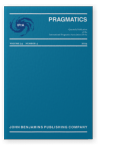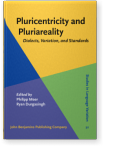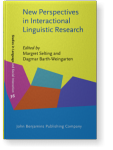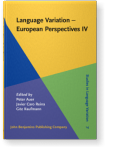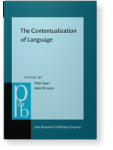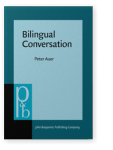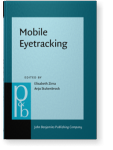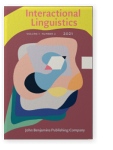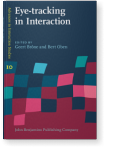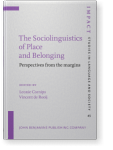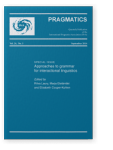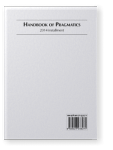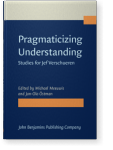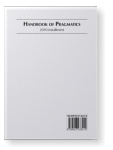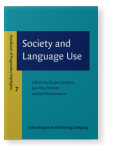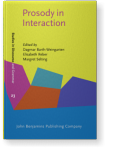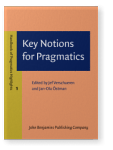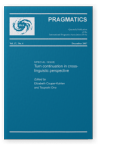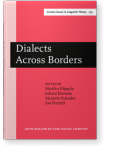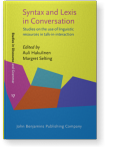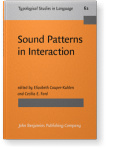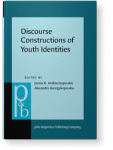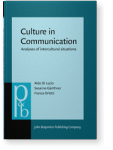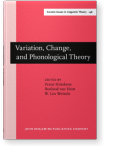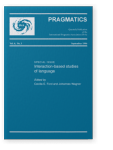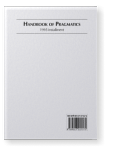Peter Auer
List of John Benjamins publications for which Peter Auer plays a role.
Journal
Book series
ISSN 1573-594X
ISSN 1872-9592
Titles
Language Variation - European Perspectives IV: Selected papers from the Sixth International Conference on Language Variation in Europe (ICLaVE 6), Freiburg, June 2011
Edited by Peter Auer, Javier Caro Reina and Göz Kaufmann
[Studies in Language Variation, 14] 2013. xiv, 296 pp.
Subjects Sociolinguistics and Dialectology | Theoretical linguistics
The Contextualization of Language
Edited by Peter Auer and Aldo Di Luzio
[Pragmatics & Beyond New Series, 22] 1992. xvi, 402 pp.
Subjects Discourse studies | Pragmatics | Theoretical linguistics
Subjects Multilingualism | Pragmatics | Sociolinguistics and Dialectology
2025 Chapter 8. Laughter and gaze among talkers on a walk Mobile Eyetracking: New avenues for the study of gaze in social interaction, Zima, Elisabeth and Anja Stukenbrock (eds.), pp. 210–243 | Chapter
While the functions of gaze in (other types of) F-formations have been the focus of a considerable amount of research, the gaze patterns found in side-by-side constellations have remained largely unexplored. In this chapter, we look at a particularly frequent, but also highly complex type of… read more
2025 Chapter 10. Joint attention without language? On intersubjectivity and the joint experience of nature Mobile Eyetracking: New avenues for the study of gaze in social interaction, Zima, Elisabeth and Anja Stukenbrock (eds.), pp. 278–311 | Chapter
We discuss the question of whether the intersubjective experience of nature requires language or whether it can be achieved by bodily means alone. Based on mobile eye-tracking data and audio recordings from walks in nature, we focus on noticings. We claim that two levels of intersubjectivity are… read more
2025 Chapter 2. Why research on gaze in social interaction needs mobile eye tracking Mobile Eyetracking: New avenues for the study of gaze in social interaction, Zima, Elisabeth and Anja Stukenbrock (eds.), pp. 24–67 | Chapter
This chapter challenges the prevailing practice in ethnomethodologically inspired interaction research (EMCA) of recording and analyzing gaze in social interactions from an observer’s perspective. Contrary to the assumption that this perspective is ‘natural’, we demonstrate systematic divergence… read more
2024 Chapter 4. Coronalisation in the German multi-ethnolect: Evidence for regional differentiation? The Continuity of Linguistic Change: Selected papers in honour of Juan Andrés Villena-Ponsoda, Vida-Castro, Matilde and Antonio Manuel Ávila-Muñoz (eds.), pp. 79–99 | Chapter
We investigate coronalisation, i.e. the fronting of the palatal fricative /ç/, in the multi-ethnolect spoken by young people in the city of Stuttgart. In contrast to a previous study on the Berlin multi-ethnolect, which claims a merger of /ç/ with /ʃ/, we only find a weak and unstable tendency… read more
2024 Noticing and assessing nature: A multimodal investigation of the format “perception imperative + exclamative” based on mobile eye-tracking data New Perspectives in Interactional Linguistic Research, Selting, Margret and Dagmar Barth-Weingarten (eds.), pp. 245–275 | Chapter
We analyze how walkers employ a verbal format, i.e., the combination of a perception imperative followed by a wie ‘how’-exclamative (e.g., KUCK ma wie TRAUMhaft das is; ‘look PTCL how wonderful that is’), in its multimodal embedding, thus contributing to a multimodal extension of interactional… read more
2021 Gaze selects the next speaker in answers to questions pronominally addressed to more than one co-participant Interactional Linguistics 1:2, pp. 154–182 | Article
Like many other languages, but unlike modern (standard) English, German has a distinct second person plural pronoun (ihr, ‘you guys’), contrasting with the second person singular pronoun (du). The second person plural pronoun addresses a turn to more than one, and possibly all co-present… read more
2021 On agency and affiliation in second assessments: German and Swedish opinion verbs in talk-in-interaction Intersubjectivity in Action: Studies in language and social interaction, Lindström, Jan K., Ritva Laury, Anssi Peräkylä and Marja-Leena Sorjonen (eds.), pp. 81–107 | Chapter
In this chapter, we discuss design features of second assessments in German and Swedish conversation. We focus on opinion-verb constructions (finden, tycka) in full and reduced clausal formats. The study shows that reduced formats are followed by sequence closure while full formats are followed… read more
2018 Chapter 9. Gaze, addressee selection and turn-taking in three-party interaction Eye-tracking in Interaction: Studies on the role of eye gaze in dialogue, Brône, Geert and Bert Oben (eds.), pp. 197–232 | Chapter
In this paper, I argue that gaze behavior in multiparty interaction is essential for addressee selection and for next-speaker selection by current speaker. The two conversational tasks are related, but – at least in longer turns – not identical and should be distinguished analytically. In… read more
2018 Chapter 4. Cité Duits: A polyethnic miners’ variety The Sociolinguistics of Place and Belonging: Perspectives from the margins, Cornips, Leonie and Vincent A. de Rooij (eds.), pp. 55–88 | Chapter
In the late 1930s and 1940s, locally born children of immigrant coal miners in Tuinwijk, a neighborhood in the village of Eisden in Belgian Limburg, developed a way of speaking among themselves which they later labelled Cité Duits. Having become coal miners themselves, they continued to use Cité… read more
2017 Chapter 14. Epilogue: Imperatives – The language of immediate action Imperative Turns at Talk: The design of directives in action, Sorjonen, Marja-Leena, Liisa Raevaara and Elizabeth Couper-Kuhlen (eds.), pp. 411–424 | Chapter
2015 The temporality of language in interaction: projection and latency Temporality in Interaction, Deppermann, Arnulf and Susanne Günthner (eds.), pp. 27–56 | Article
This paper focuses on two basic principles in the dialogical emergence of self-contained linguistic units (‘sentences’) in interaction: projection and latency. Both are elementary for the synchronization of participants’ minds in what I call the online emergence of syntax. Projection enables… read more
2014 Syntactic structures and their symbiotic guests: Notes on analepsis from the perspective of online syntax Approaches to grammar for interactional linguistics, Laury, Ritva, Marja Etelämäki and Elizabeth Couper-Kuhlen (eds.), pp. 533–560 | Article
The empirical focus of this paper is on utterances that re-use syntactic structures from a preceding syntactic unit. Next utterances of this type are usually treated as (coordination) ellipsis. It is argued that from an on-line perspective on spoken syntax, they are better described as structural… read more
2014 John J. Gumperz Handbook of Pragmatics: 2014 Installment, Östman, Jan-Ola and Jef Verschueren (eds.) | Article
2013 Introduction Language Variation - European Perspectives IV: Selected papers from the Sixth International Conference on Language Variation in Europe (ICLaVE 6), Freiburg, June 2011, Auer, Peter, Javier Caro Reina and Göz Kaufmann (eds.), pp. vii–xiv | Article
2012 Spatial indexicalities and spatial pragmatics Pragmaticizing Understanding: Studies for Jef Verschueren, Meeuwis, Michael and Jan-Ola Östman (eds.), pp. 53–76 | Article
This paper argues for a rapprochement between the two hitherto entirely separate linguistic research traditions that have as their topic the relationship of space and language. This is on the one hand research on spatial deixis, which focuses on how languages are equipped to deal with location and… read more
2010 Code-switching Handbook of Pragmatics: 2010 Installment, Östman, Jan-Ola and Jef Verschueren (eds.), pp. 1–34 | Article
2010 Code-switching Society and Language Use, Jaspers, Jürgen, Jan-Ola Östman and Jef Verschueren (eds.), pp. 84–112 | Article
2010 Retrieving, redoing and resuscitating turns in conversation Prosody in Interaction, Barth-Weingarten, Dagmar, Elisabeth Reber and Margret Selting (eds.), pp. 131–160 | Article
Not infrequently in conversation, a speaker launches an activity which in some way or other is intercepted by another co-participant, or is otherwise unsuccessful, such that it receives no proper uptake. Activities of this kind may simply be lost. However, speakers who did not succeed may also ‘try… read more
2009 Context and contextualization Key Notions for Pragmatics, Verschueren, Jef and Jan-Ola Östman (eds.), pp. 86–101 | Article
2007 Why are increments such elusive objects? An afterthought Turn continuation in cross-linguistic perspective, Couper-Kuhlen, Elizabeth and Tsuyoshi Ono (eds.), pp. 647–658 | Article
It is argued that the type of unit expansions called ‘increments’ by Schegloff 1996 is too narrowly focused on English. While the structure of English makes it particularly suited for this kind of expansion, a typologically more satisfactory approach to unit expansion runs into problems if it… read more
2005 The construction of linguistic borders and the linguistic construction of borders Dialects Across Borders: Selected papers from the 11th International Conference on Methods in Dialectology (Methods XI), Joensuu, August 2002, Filppula, Markku, Juhani Klemola, Marjatta Palander and Esa Penttilä (eds.), pp. 3–30 | Article
2005 Delayed self-repairs as a structuring device for complex turns in conversation Syntax and Lexis in Conversation: Studies on the use of linguistic resources in talk-in-interaction, Hakulinen, Auli and Margret Selting (eds.), pp. 75–102 | Article
2004 Prolixity as adaptation: Prosody and turn-taking in German conversation with a fluent aphasic Sound Patterns in Interaction: Cross-linguistic studies from conversation, Couper-Kuhlen, Elizabeth and Cecilia E. Ford (eds.), pp. 171–200 | Article
2003 Socio-cultural orientation, urban youth styles and the spontaneous acquisition of Turkish by non-Turkish adolescents in Germany Discourse Constructions of Youth Identities, Androutsopoulos, Jannis and Alexandra Georgakopoulou (eds.), pp. 223–246 | Article
2001 Three Ways of Analysing Communication between East and West Germans as Intercultural
Communication Culture in Communication: Analyses of intercultural situations, Di Luzio, Aldo, Susanne Günthner and Franca Orletti (eds.), pp. 89–116 | Article
1997 Co-Occurrence Restrictions between Linguistic Variables: A Case for Social Dialectology, Phonological Theory and Variation Studies Variation, Change, and Phonological Theory, Hinskens, Frans, Roeland van Hout and W. Leo Wetzels (eds.), pp. 69–100 | Article
1996 The pre-front field in spoken german and its relevance as a grammaticalization position Interaction-based studies of language, Ford, Cecilia E. and Johannes Wagner (eds.), pp. 295–322 | Article
1996 Context and contextualization Handbook of Pragmatics: 1995 Installment, Verschueren, Jef, Jan-Ola Östman, Jan Blommaert † and Chris Bulcaen (eds.), pp. 1–19 | Article
1992 Introduction: John Gumperz’ Approach to Contextualization The Contextualization of Language, Auer, Peter and Aldo Di Luzio (eds.), pp. 1–38 | Article
1990 Isochrony and ‘Uncomfortable Moments’ in Conversation Learning, Keeping and Using Language: Selected papers from the Eighth World Congress of Applied Linguistics, Sydney, 16–21 August 1987, Halliday, M.A.K. †, John Gibbons and Howard Nicholas (eds.), pp. 269–282 | Article
